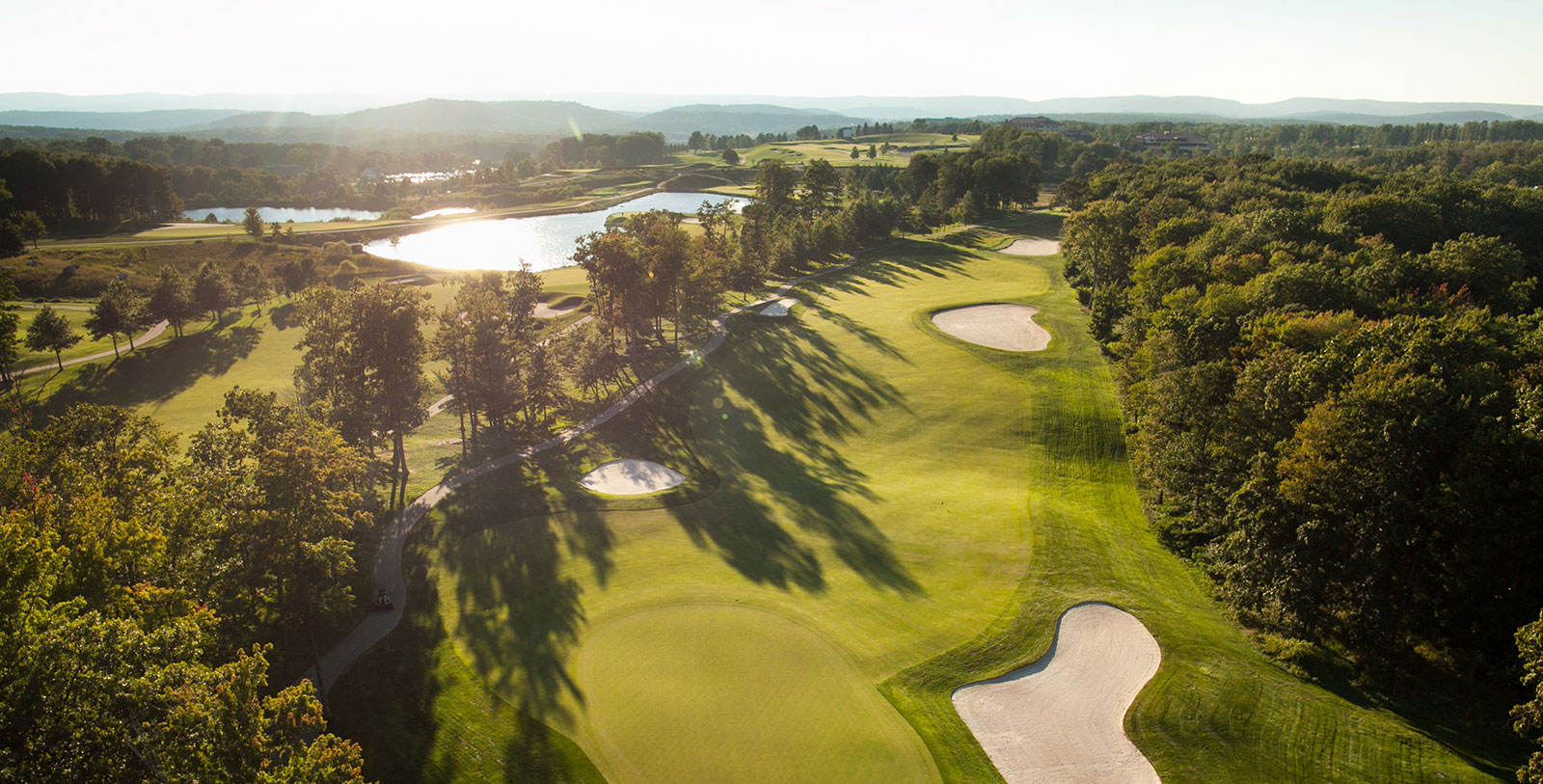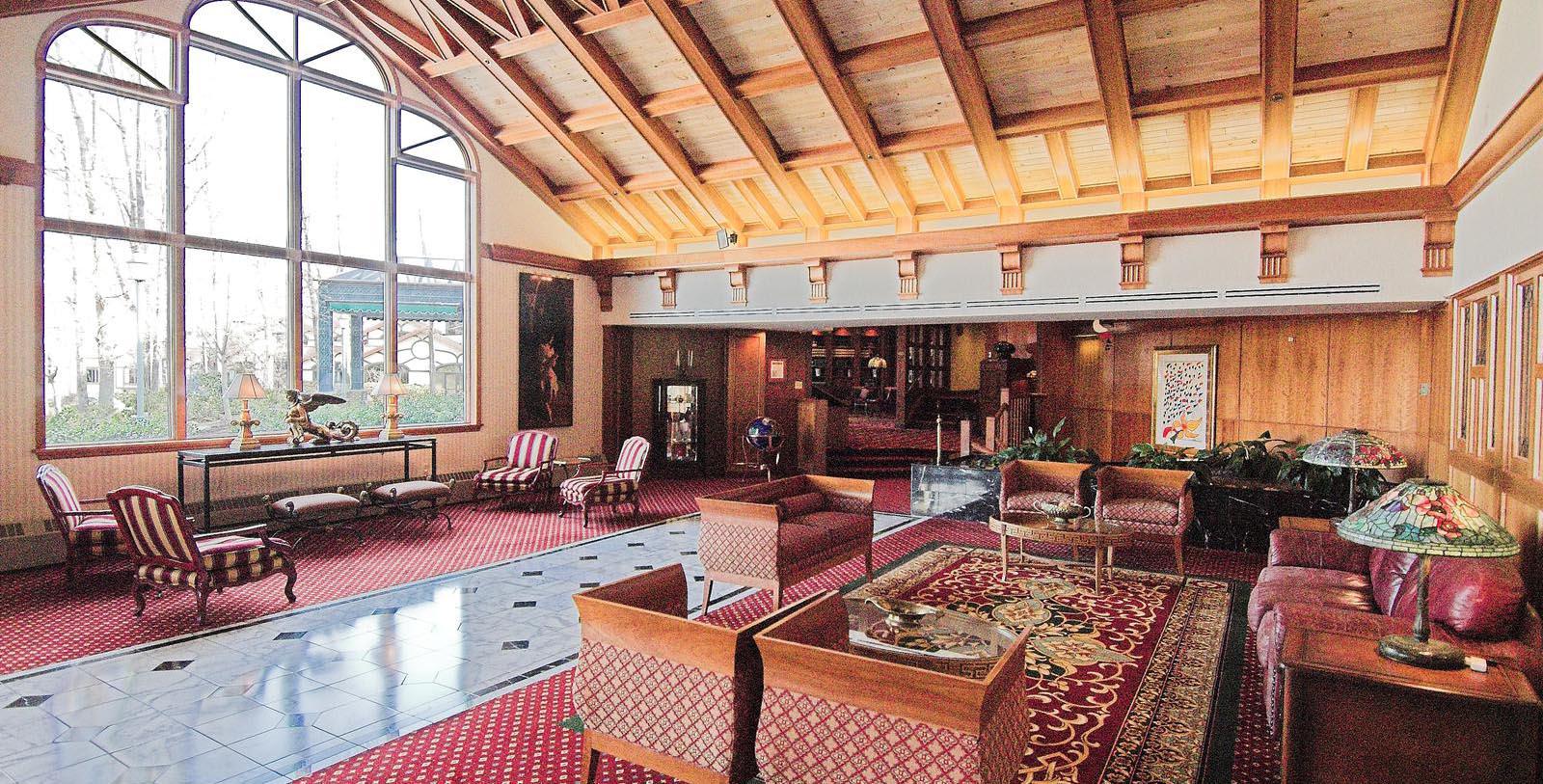Receive for Free - Discover & Explore eNewsletter monthly with advance notice of special offers, packages, and insider savings from 10% - 30% off Best Available Rates at selected hotels.
farmington golf courses
Discover Mystic Rock and Shepherd’s Rock, which were both designed by the legendary golf course architect, Pete Dye.
Championship-caliber golf arrived at Nemacolin when the fantastic Mystic Rock course made its debut during the 1990s. The dream of the resort’s founder, Joseph Hardy, every hole had been developed by the genius of legendary golf course architect Pete Dye. In 1995, he proceeded to craft a beautiful course that offered spectacular views of the surrounding Laurel Highlands. Its layout was challenging, featuring a collection of hazards that granted players an incredibly rewarding experience. Over time, the newly created Mystic Rock course quickly became one of Pennsylvania’s most sought-after destinations to play a round of golf. Perhaps the best example of its newfound prestige came when Joseph Hardy’s own company, 84 Lumber, arranged for the course to host the Pennsylvania Classic. Part of the PGA Tour, Mystic Rock acted as the site for three respective Pennsylvania Classics in 2003. One of the most memorable moments to occur at the tournament was the entrance of a young Michelle Wie, who entered the 2006 Pennsylvania Classic upon the personal invitation of Hardy himself. While Wie shot 14 over par, her time at the tournament nonetheless helped jumpstart her celebrated professional career. Golf’s popularity at Nemacolin only continued to rise, prompting the Hardy family to commission the creation of yet another fantastic golf course—Shepherd’s Rock. The Hardys subsequently brought back Pete Dye to spearhead the project, who proceeded to craft a magnificent course that brilliantly stretched across the Allegheny Mountains. Open since 2017, Shepherd’s Rock has since served as a terrific companion to the renowned Mystic Rock. Both courses continue to form the heart of Nemacolin’s golf experience, which continued to enchant guests to this day. The Nemacolin Golf Academy itself features a wealth of state-of-the-art facilities, including advanced training technology, four specialized bays, and space to accommodate groups as large as 60 people. Guests visiting The Lodge at Nemacolin have access to these fantastic two courses.
-
About the Location +
The Lodge at Nemacolin is located in the quaint village of Farmington, a hamlet that is part of the much larger Wharton Township. Both communities sit around an hour outside of Pittsburgh in the verdant Laurel Highlands. The Laurel Highlands themselves have long been frequented by families from the greater Pittsburgh area for generations. Many visitors have found its unique landscape well-suited for such outdoor activities as camping, hiking, hunting, kayaking, and even skiing. But the Laurel Highlands hare also replete with their own fascinating history, which spans back centuries. Farmington itself is actually one of the closest settlements to the site of Fort Necessity, an 18th-century citadel that famously saw service during the French and Indian War. In 1754, George Washington, then just a colonel in the colonial British military, created the rudimentary wooden palisade while leading some 400 soldiers against the French stationed at Fort Duquesne (now the site of present-day Pittsburgh). A few months earlier, Washington had been tasked by Virginia’s lieutenant governor, Robert Dinwiddie, with stopping any potential invasions from the French fort. Washington then led a portion of his command deep into the unsettled Pennsylvania wilderness, where he confronted a detachment of French militia in what was referred to as the “Battle of Jumonville Glen.” Despite being a victory for Washington, the incident helped spark the French and Indian War. The French subsequently resolved to counterattack and gathered a force of some 700 men to strike Washington.
Realizing the tenuous position his army held, Washington ordered the construction of Fort Necessity as a means of protecting his army’s supply lines. He then spent the next couple of weeks trying to move his small force in the direction of Fort Duquesne, working feverishly to widen any forest trails that his men encountered. Unfortunately, Washington’s column retreated once word arrived that the French were quickly moving toward his position. Arriving back at Fort Necessity, Washington had his men create a series of basic trenches and breastworks around the fort. But a massive rainstorm ensued, which made the construction nearly impossible to complete. On July 3, the French and their Indian allies conducted a front assault on Washington’s position, causing a great panic among his untrained colonial soldiers. While a small group of British regulars managed to delay the French, the French nevertheless managed to pin Washington’s whole force within the cramped confines of Fort Necessity. Washington desperately tried to encourage his fellow Virginians to fire back at the French, but their lack of discipline made them ineffective in combat. Acknowledging the hopelessness of the situation, Washington eventually surrendered to the French. Despite the battle leaving a dishonorable mark on Washington’s reputation, he would later use his battle experience to successfully lead the Continental Army in the American Revolutionary War.
Another historic site near The Lodge of Nemacolin is U.S. Route 40, known to history as the “National Road.” Also remembered as the “Cumberland Road,” the National Road was the first major public highway ever built by the federal government. With thousands of American settlers traversing the Alleghany Mountains to reach the Ohio River, Congress recognized the need to develop a road that could help them traverse the Midwest. Both chambers officially commissioned the construction of the road in 1806, although the private contractors were not selected until a few years later in 1811. Construction evenutally commenced after the War of 1812, with Cumberland, Maryland, serving as the road’s first terminus. The project surveyors and engineers specifically picked a historic Indian path known as “Nemacolin’s Trail” to serve as a guide for the new road. Laborers worked diligently to push the route through the dense forests of what is now West Virginia, ultimately reaching the town of Wheeling in 1817. The private contractors continued to extend the thoroughfare deeper into the nascent United States over the next two decades, gradually expanding into Ohio and Indiana before reaching central Illinois in the 1830s. Congress considered building its final extension toward St. Louis, but the advent of the railroads discouraged such measures from passing as law. Despite its unfinished state, the National Road has since become one of the most heavily traveled routes in U.S. history. In fact, the National Road has even been designated as a National Scenic Byway called the “Historic National Road.”
-
About the Architect +
Pete Dye: Hailed as the most influential golf architect of the last half-century, architect Pete Dye has left a legacy on the golfing world. An avid golfer from a young age, Dye first played the sport competitively while in high school. He continued to golf when he enlisted in the United States military upon graduating. While stationed at Fort Bragg, Dye worked as the greenskeeper for the base’s golf course. He also met the prominent Donald Ross, who was then still serving as the main professional at Pinehurst Resort. The meeting greatly affected Dye’s passion for the game, which he kept following as a student at Rollins College. He subsequently met Alice Holliday O’Neal and the two were married not long thereafter. They eventually moved to her hometown of Indianapolis, Indiana, where he got a job selling policies with The Connecticut Mutual Life Insurance Company. Even though Ross thrived in insurance, he still loved golf dearly. He thus entered into numerous amateur championships in Indiana during the 1950s and built a considerable reputation for himself. He even used the experience to eventually compete in the 57th U.S. Open. Although Dye failed to advance deep in the tournament, he still finished ahead of future greats Jack Nicklaus and Arnold Palmer. In 1961, Dye decided to leave the insurance industry behind to pursue his passion for golf full-time. With close support of his wife, Dye specifically formed his own golf landscaping firm. Dye’s very first project involved creating a magnificent nine-hole course called “El Dorado,” which became notorious for its water hazards.
However, his first big project transpired when he obtained the commission to craft the marvelous 18-hole course at Crooked Stick Golf Club. Receiving rave reviews, Dye was soon earning numerous commissions all over the United States. Many of his designs soon became incredibly popular, including Harbour Town Golf Links, Whistling Straits, and the Ocean Course at Kiawah Island. His greatest accomplishment was the TPC at Sawgrass’ Stadium Course. Noted for its great difficulty, his par-three 17th hole has since been referred to as the “world’s most terrifying tee shot.” Much of Dye’s designs were inspired by Scottish design principles, namely the use of pot bunkers, wooden bulkheads, and small greens. But Dye also invented his own fascinating greenskeeping practices, too, such as the implementation of railroad ties to help hold down bunkers. Among the courses that Dye designed with such principles were the two that appeared at Nemacolin over the course of three decades—Mystic Rock and Shepherd’s Rock. Mystic Rock was the first to debut in the 1990s, featuring Dye’s patented use of intricate hazards and challenging greens. He later applied similar principles to Shepherd’s Rock more than 20 years later right before his death in 2020. Both courses still proudly feature Dye’s stunning array of rolling fairways, exciting bunkers, and outstanding landscaping today.


































